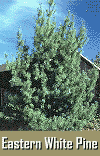Pine
In their importance to the lumber industry, their role in the history of the United States, and the beauty they bring to vast areas of the country, pines are vital American trees. This diverse family of cone-bearing evergreens is generally distinguished by resinous wood, needle-like leaves held in bundles, and a single straight trunk, bedecked with tiers or whorls of lateral branches. Pines are typically cone-shaped when young, with more rounded tops developing in age. Thirty-six pine species are found in the United States, with many found in both the east and west.
The Pine’s Place in History
Few trees had a more immediate, or profound, impact on the first American explorers and settlers. The vast eastern white pine forests that met the first settlers soon provided these intrepid men and women lumber for their homes, schools, and churches. The towering white pines, coveted for the masts of sailing ships, even played a role in the fight for independence, as the colonists united against Britain in part because of the King’s claiming of the largest white pines for the Royal Navy. Native Americans and early settlers also found many medicinal uses for pine bark and resin, and pine gum was a popular caulk or sealant for houses and canoes. Westering pioneers found an even more intriguing use for this versatile tree, planting “coffin pines” in their new homes, often in pairs for husband and wife, since the standing hardwood forests they encountered in some areas presented less workable wood than the softer pine. Native pine forests of the western United States were the foundation of the lumber industry.
Some Common Species
Eastern white pine (Pinus strobus), the tallest tree native to eastern North America, was one of the dominant forest giants that greeted the first English settlers. While these towering virgin forests no longer exist, the white pine remains important in the Christmas tree and lumber industries as well as for its landscape value. In a park or large yard or garden, the white pine will grow to 100 feet or more, while the national co-champions, both growing in Marquette, Minnesota, stand at 201 feet tall and 15 feet in trunk circumference and 181 feet with a 17-foot circumference. The eastern white pine grows naturally throughout New England, the Appalachian highlands, and the Great Lakes region. (Grows in hardiness zones 3 to 8.)
Loblolly pine (Pinus taeda) is an important American timber tree that is also cloaked in beauty during much of the year. With a natural range across the southeastern United States, the loblolly pine is distinguished by its large, columnar trunk, attractive bark in broad, reddish brown plates, and its pale green needles. This large tree often grows to 100 feet tall with a spread up to 50 feet, and with a youthful pyramidal shape becoming more oval at maturity. The tree takes its unusual name from an Old English word meaning “porridge,” in reference to the damp, muddy areas in which the tree often grows. (Grows in hardiness zones 6 to 9.)
The bristlecone pine (Pinus aristata) holds many distinctions—including being considered the world’s oldest known living tree, with one specimen claimed to be more than 4,600 years old. Growing in the harsh timberline areas of America’s mountains, a six-foot tall tree may be 900 years old. At lower elevations, the tree can grow from 40 to 50 feet tall, with red-brown bark and a more pyramidal shape, but it is most often found higher up and gnarled in appearance, with branches shooting upward at unusual angles. The bristlecone pine grows naturally in mountainous areas of Colorado, Utah, Nevada, New Mexico, California, and Arizona, often at even higher elevations than the subalpine fir. (Grows in hardiness zones 4 to 7.)

Pinus
Species
- Apache Pine
- Austrian Pine
- Bishop Pine
- Bristlecone Pine
- Chihuahua Pine
- Colorado Pinyon Pine
- Coulter Pine
- Digger Pine
- Eastern White Pine
- Foxtail Pine
- Jack Pine
- Jeffrey Pine
- Monterey Pine
- Parry Pinyon Pine
- Pinyon Pine
- Pitch Pine
- Ponderosa Pine
- Red Pine
- Scotch Pine
- Scots Pine
- Scrub Pine
- Shortleaf Pine
- Singleleaf Pinyon Pine
- Slash Pine
- Southwestern White Pine
- Sugar Pine
- Torrey Pine
- Western White Pine
- Whitebark Pine
